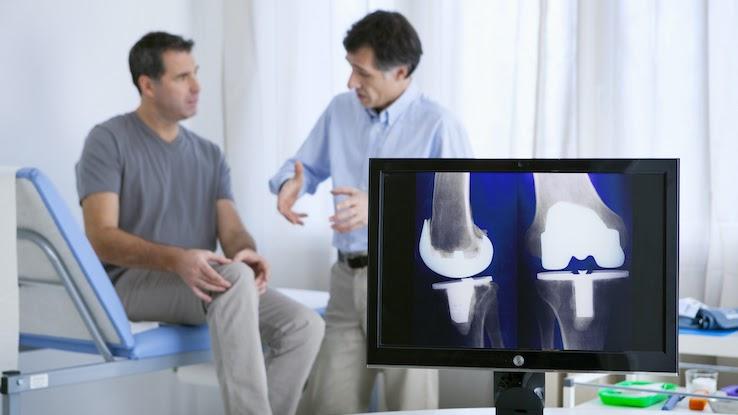How to Sleep on Your Back After Knee Replacement

Knee replacement surgery, also known as knee arthroplasty, replaces joints in the knee that are damaged or worn. Total knee replacement surgery is a procedure in which damaged cartilage and bones of the knee are removed and replaced with artificial metal joints and plastic spacers. Depending on the extent of the damage to the knee, the kneecap may also be resurfaced and covered with a protective plastic button.
The procedure is typically recommended for individuals with osteoarthritis and those with damaged knees due to severe injuries. A partial knee replacement is similar except that one joint is replaced, and the kneecap may or may not need to be resurfaced, which results in a shorter recovery time. This procedure is usually recommended to people aged 55 to 64, but the prosthetic used often needs to be replaced in about 10 years.
If your knees are damaged and painful, the surgery can help reduce pain and improve your quality of life. However, there are some risks associated with the surgery and potential problems with recovery. Exercise can help strengthen your knee muscles before and after the surgery, which can help in the recovery process.
Knee Replacement Risks
Total knee replacement surgery is considered a low-risk procedure. There are still certain risks involved, including complications from surgical anesthesia, blood clots and infections. Adverse reactions to anesthesia include irregular heartbeats, nerve injuries and stomach problems.
To avoid a potential reaction, it's important to let your healthcare provider know of potential risk factors you have, such as tobacco use, prior health conditions or medications that may interact with the anesthesia. Blood clots are most likely to occur within two weeks following the procedure, but they can also develop during surgery. Your healthcare provider may prescribe blood-thinning medications to prevent blood clots.
Infections are considered rare with knee replacement surgery. In most cases, healthcare providers prescribe antibiotics before and after the surgery to prevent infection. If a major infection occurs, another surgery may be necessary. Additional risks include implant failure, ongoing knee pain, and injury to the surrounding muscles and blood vessels.
Knee Replacement Recovery
While recovery periods can vary, patients typically experience significant improvement within a month to six weeks from the date of surgery. On rare occasions, the knee can take up to two years to fully heal. Patients are usually required to stay in the healthcare facility for up to three days following the procedure, after which they're provided with a walker or crutches to support their knees. In about six weeks' time, many patients are able to walk with minimal support. However, full recovery normally requires physical therapy in order to strengthen the muscles.
Knee Replacement Exercises
Before the surgery, it's recommended that you continue to do light exercises like swimming or walking to strengthen the muscles around your knee. While it's common to experience pain and discomfort during the recovery period, exercise is essential when it comes to rebuilding strength and adjusting to your new implant. People who've had knee replacements sometimes start strengthening movements as soon as a few hours after surgery. After a couple days, you'll be instructed to start doing short walks inside your home to increase your mobility. When your legs feel strong enough, longer outdoor walks are usually recommended.
Knee replacement patients are also advised to resume their everyday activities, such as climbing stairs and performing light housework, as these activities help to strengthen the muscles and joints. In addition to daily activities, your surgeon will prescribe specific knee-strengthening exercises you'll need to perform up to three times a day. These usually include knee bends, thigh stretches and ankle stretches, and you can complete them at home or with the assistance of a healthcare professional.
Elevating your leg and putting ice on your knee can help with any swelling or pain that may occur after exercising.
A total knee replacement is the replacing of both sides of the knee joint with plastic or metal prosthetics. In a partial knee replacement, only one part of the knee joint is replaced. If your healthcare provider suggests a knee replacement procedure, it's important to educate yourself on the potential risk factors involved with the surgery and the recovery process, as your activity will be limited for a period of time in order to promote proper healing.
Resource Links:
https://www.nhs.uk/conditions/knee-replacement/
https://orthoinfo.aaos.org/en/recovery/total-knee-replacement-exercise-guide/
https://orthoinfo.aaos.org/en/treatment/total-knee-replacement/
https://www.mayoclinic.org/tests-procedures/knee-replacement/about/pac-20385276
MORE FROM SYMPTOMFIND.COM
How to Sleep on Your Back After Knee Replacement
Source: https://www.symptomfind.com/health/knee-replacement-101?utm_content=params%3Ao%3D740013%26ad%3DdirN%26qo%3DserpIndex
0 Response to "How to Sleep on Your Back After Knee Replacement"
Post a Comment